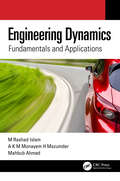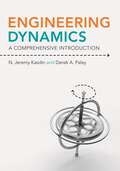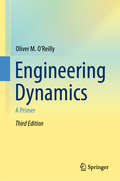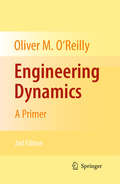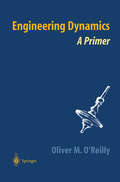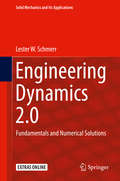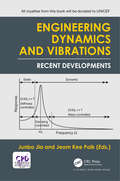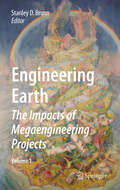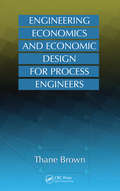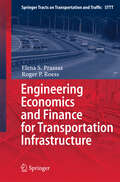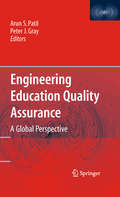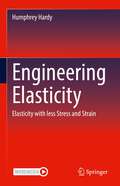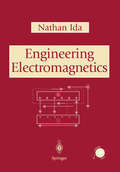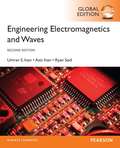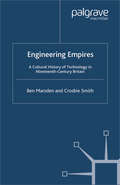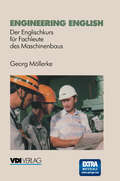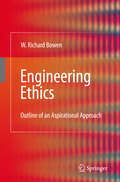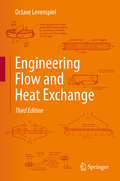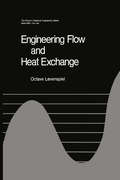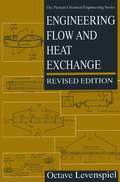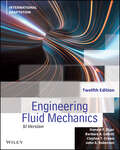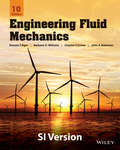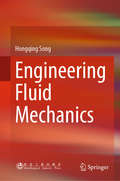- Table View
- List View
Engineering Dynamics: Fundamentals and Applications
by M Rashad Islam A K Mazumder Mahbub AhmedThis textbook is intended for the first course of engineering dynamics for undergraduate students. Engineering dynamics is a rigorous topic that typically involves the intensive use of vector mathematics and calculus. This book, however, uses plain language with less vector mathematics and calculus to introduce these topics of mathematics to students with a high school physics background. Numerous practical examples are provided with their step-by-step worked out solutions, as well as case studies to reflect the interests of new engineering and applied engineering students. The topics covered in the Fundamentals of Engineering (FE) examination are presented throughout the text. It also includes roadway dynamics to incorporate engineering dynamics and transportation engineering for civil engineering. Features: Discusses theory using easy-to-understand language with less vector mathematics and calculus Includes practical case studies and numerous realistic step-by-step solved examples Includes exercise problems for students’ practice Provides numerous sample examples related to the Fundamentals of Engineering (FE) exam Includes a solutions manual and PowerPoint slides for adopting instructors Engineering Dynamics: Fundamentals and Applications serves as a useful resource for students across several engineering degree programs, such as civil, mechanical, aerospace, automotive, chemical, and electrical engineering. It is also appropriate for engineering technology and applied science students as well.
Engineering Dynamics: A Comprehensive Introduction
by N. Jeremy Kasdin Derek A. PaleyThis textbook introduces undergraduate students to engineering dynamics using an innovative approach that is at once accessible and comprehensive. Combining the strengths of both beginner and advanced dynamics texts, this book has students solving dynamics problems from the very start and gradually guides them from the basics to increasingly more challenging topics without ever sacrificing rigor. Engineering Dynamics spans the full range of mechanics problems, from one-dimensional particle kinematics to three-dimensional rigid-body dynamics, including an introduction to Lagrange's and Kane's methods. It skillfully blends an easy-to-read, conversational style with careful attention to the physics and mathematics of engineering dynamics, and emphasizes the formal systematic notation students need to solve problems correctly and succeed in more advanced courses. This richly illustrated textbook features numerous real-world examples and problems, incorporating a wide range of difficulty; ample use of MATLAB for solving problems; helpful tutorials; suggestions for further reading; and detailed appendixes. Provides an accessible yet rigorous introduction to engineering dynamics Uses an explicit vector-based notation to facilitate understanding Professors: A supplementary Instructor's Manual is available for this book. It is restricted to teachers using the text in courses. For information on how to obtain a copy, refer to: http://press.princeton.edu/class_use/solutions.html
Engineering Dynamics: A Comprehensive Introduction
by N. Jeremy Kasdin Derek A. PaleyAn accessible yet rigorous introduction to engineering dynamicsThis textbook introduces undergraduate students to engineering dynamics using an innovative approach that is at once accessible and comprehensive. Combining the strengths of both beginner and advanced dynamics texts, this book has students solving dynamics problems from the very start and gradually guides them from the basics to increasingly more challenging topics without ever sacrificing rigor.Engineering Dynamics spans the full range of mechanics problems, from one-dimensional particle kinematics to three-dimensional rigid-body dynamics, including an introduction to Lagrange's and Kane's methods. It skillfully blends an easy-to-read, conversational style with careful attention to the physics and mathematics of engineering dynamics, and emphasizes the formal systematic notation students need to solve problems correctly and succeed in more advanced courses. This richly illustrated textbook features numerous real-world examples and problems, incorporating a wide range of difficulty; ample use of MATLAB for solving problems; helpful tutorials; suggestions for further reading; and detailed appendixes.Provides an accessible yet rigorous introduction to engineering dynamicsUses an explicit vector-based notation to facilitate understandingProfessors: A supplementary Instructor's Manual is available for this book. It is restricted to teachers using the text in courses. For information on how to obtain a copy, refer to: https://press.princeton.edu/class_use/solutions.html
Engineering Dynamics: A Primer
by Oliver M. O'ReillyThis Primer is intended to provide the theoretical background for the standard undergraduate, mechanical engineering course in dynamics. The book contains several worked examples and summaries and exercises at the end of each chapter to aid readers in their understanding of the material. Teachers who wish to have a source of more detailed theory for the course, as well as graduate students who need a refresher course on undergraduate dynamics when preparing for certain first year graduate school examinations, and students taking the course will find the work very helpful.
Engineering Dynamics: A Primer
by Oliver M. O'ReillyThis Primer is intended to provide the theoretical background for the standard undergraduate, mechanical engineering course in dynamics. The book contains several worked examples and summaries and exercises at the end of each chapter to aid readers in their understanding of the material. Teachers who wish to have a source of more detailed theory for the course, as well as graduate students who need a refresher course on undergraduate dynamics when preparing for certain first year graduate school examinations, and students taking the course will find the work very helpful.
Engineering Dynamics: A Primer
by Oliver M. O'ReillyThis Primer is intended to provide the theoretical background for the standard undergraduate, mechanical engineering course in dynamics. The book contains several worked examples and summaries and exercises at the end of each chapter to aid readers in their understanding of the material. Teachers who wish to have a source of more detailed theory for the course, as well as graduate students who need a refresher course on undergraduate dynamics when preparing for certain first year graduate school examinations, and students taking the course will find the work very helpful.
Engineering Dynamics 2.0: Fundamentals and Numerical Solutions (Solid Mechanics and Its Applications #254)
by Lester W. SchmerrThis book presents a new approach to learning the dynamics of particles and rigid bodies at an intermediate to advanced level. There are three distinguishing features of this approach. First, the primary emphasis is to obtain the equations of motion of dynamical systems and to solve them numerically. As a consequence, most of the analytical exercises and homework found in traditional dynamics texts written at this level are replaced by MATLAB®-based simulations. Second, extensive use is made of matrices. Matrices are essential to define the important role that constraints have on the behavior of dynamical systems. Matrices are also key elements in many of the software tools that engineers use to solve more complex and practical dynamics problems, such as in the multi-body codes used for analyzing mechanical, aerospace, and biomechanics systems. The third and feature is the use of a combination of Newton-Euler and Lagrangian (analytical mechanics) treatments for solving dynamics problems. Rather than discussing these two treatments separately, Engineering Dynamics 2.0 uses a geometrical approach that ties these two treatments together, leading to a more transparent description of difficult concepts such as "virtual" displacements.Some important highlights of the book include: Extensive discussion of the role of constraints in formulating and solving dynamics problems.Implementation of a highly unified approach to dynamics in a simple context suitable for a second-level course.Descriptions of non-linear phenomena such as parametric resonances and chaotic behavior.A treatment of both dynamic and static stability.Overviews of the numerical methods (ordinary differential equation solvers, Newton-Raphson method) needed to solve dynamics problems.An introduction to the dynamics of deformable bodies and the use of finite difference and finite element methods.Engineering Dynamics 2.0 provides a unique, modern treatment of dynamics problems that is directly useful in advanced engineering applications. It is a valuable resource for undergraduate and graduate students and for practicing engineers.
Engineering Dynamics and Vibrations
by Junbo Jia Jeom Kee PaikEngineering dynamics and vibrations has become an essential topic for ensuring structural integrity and operational functionality in different engineering areas. However, practical problems regarding dynamics and vibrations are in many cases handled without success despite large expenditures. This book covers a wide range of topics from the basics to advances in dynamics and vibrations; from relevant engineering challenges to the solutions; from engineering failures due to inappropriate accounting of dynamics to mitigation measures and utilization of dynamics. It lays emphasis on engineering applications utilizing state-of-the-art information.
Engineering Dynamics and Vibrations
by Junbo Jia Jeom Kee PaikEngineering dynamics and vibrations has become an essential topic for ensuring structural integrity and operational functionality in different engineering areas. However, practical problems regarding dynamics and vibrations are in many cases handled without success despite large expenditures. This book covers a wide range of topics from the basics to advances in dynamics and vibrations; from relevant engineering challenges to the solutions; from engineering failures due to inappropriate accounting of dynamics to mitigation measures and utilization of dynamics. It lays emphasis on engineering applications utilizing state-of-the-art information.
Engineering Earth: The Impacts of Megaengineering Projects
by Stanley D. BrunnThis is the first book to examine the actual impact of physical and social engineering projects in more than fifty countries from a multidisciplinary perspective. The book brings together an international team of nearly two hundred authors from over two dozen different countries and more than a dozen different social, environmental, and engineering sciences. Together they document and illustrate with case studies, maps and photographs the scale and impacts of many megaprojects and the importance of studying these projects in historical, contemporary and postmodern perspectives. This pioneering book will stimulate interest in examining a variety of both social and physical engineering projects at local, regional, and global scales and from disciplinary and trans-disciplinary perspectives.
Engineering Economics and Economic Design for Process Engineers
by Thane BrownEngineers often find themselves tasked with the difficult challenge of developing a design that is both technically and economically feasible. A sharply focused, how-to book, Engineering Economics and Economic Design for Process Engineers provides the tools and methods to resolve design and economic issues. It helps you integrate technical a
Engineering Economics and Finance for Transportation Infrastructure (Springer Tracts on Transportation and Traffic #3)
by Elena S. Prassas Roger P. RoessThis textbook provides a fundamental overview of the application of engineering economic principles to transportation infrastructure investments. Basic theory is presented and illustrated with examples specific to the transportation field. It also reviews the history of transportation finance, as well as current methods for funding transportation investments in the U.S. Future problems and potential solutions are also discussed and illustrated.
Engineering Education Quality Assurance: A Global Perspective
by Arun Patil Peter GrayWith the rapid globalization of higher education as well as related changes in social, political, economic, and other conditions over the last 25 years there have been ever increasing expectations for higher education, in general, and Engineering Education, in particular. These expectations are often expressed in terms of the need for Quality Assurance locally, regionally, and globally. In some cases, there is a long tradition of independence and self-regulation of higher education institutions and programs. In other contexts, there has been c- siderable governmental regulation and disciplinary direction over time. The authors in this volume represent essentially all continents and 15 different countries. The common issues that they raise and their accounts of past, present, and future ch- lenges provide a snapshot of the current state of Quality Assurance in higher edu- tion and Engineering Education. This volume begins with an overview of the history and background of Quality Assurance in higher education and Engineering Education over the last century. The discussion of the historical, philosophical, political, and social background of Quality Assurance sets the stage for the other chapters. Following this broad brush stoke introduction, in the next part of the book, authors describe the general issues and challenges facing Quality Assurance in the twenty-first century from both regional and national perspectives. These authors have extensive experience in the area of Quality Assurance and have observed its growth and develop first hand over many years.
Engineering Elasticity: Elasticity with less Stress and Strain
by Humphrey HardyThis textbook aimed at upper-level undergraduate and graduate engineering students who need to describe the large deformation of elastic materials like soft plastics, rubber, and biological materials. The classical approaches to finite deformations of elastic materials describe a dozen or more measures of stress and strain. These classical approaches require an in-depth knowledge of tensor analysis and provide little instruction as to how to relate the derived equations to the materials to be described. This text, by contrast, introduces only one strain measure and one stress measure. No tensor analysis is required. The theory is applied by showing how to measure material properties and to perform computer simulations for both isotropic and anisotropic materials. The theory can be covered in one chapter for students familiar with Euler-Lagrange techniques, but is also introduced more slowly in several chapters for students not familiar with these techniques. The connection to linear elasticity is provided along with a comparison of this approach to classical elasticity.
Engineering Electromagnetics
by Nathan IdaThis text provides a good theoretical understanding of the electromagnetic field equations while also treating a large number of applications. In fact, no topic is presented unless it is directly applicable to engineering design or unless it is needed for the understanding of another topic. Electric motors and transformers are used to demonstrate the ideas of magnetic forces and torques and of induction; the applications discussed include the new super-efficient electric drives, linear induction motors, and implantable transformers to power life-sustaining devices. The discussion of wave-propagation phenomena includes applications of new materials to aerospace systems, such as the so-called stealth materials, as well as the use of electromagnetic weaves for materials processing, such as grain drying with microwaves, microwave detection of explosives, and remote sensing of the earth and its resources.
Engineering Electromagnetics and Waves, Global Edition
by Aziz Inan S. Inan Umran Ryan SaidFor courses in Electromagnetic Fields & Waves.Electromagnetic Waves continues the applied approach used in the authors' successful Engineering Electromagnetics. The second book is appropriate for a second course in Electromagnetics that covers the topic of waves and the application of Maxwell's equations to electromagnetic events.
Engineering Empires: A Cultural History of Technology in Nineteenth-Century Britain
by B. Marsden C. SmithEngineers are empire-builders. Watt, Brunel, and others worked to build and expand personal and business empires of material technology and in so doing these engineers also became active agents of political and economic empire. This book provides a fascinating exploration of the cultural construction of the large-scale technologies of empire.
Engineering English: Der Englischkurs für Fachleute des Maschinenbaus (VDI-Buch)
by Georg MöllerkeDieser kurzweilige Englischkurs, der gute Schulkenntnisse voraussetzt, bringt Themen aus der Praxis des Maschineningenieurs, wie sie im beruflichen Alltag am häufigsten vorkommen. Die Grammatik ist auf das Nötigste beschränkt.
Engineering Ethics: Outline of an Aspirational Approach
by William Richard BowenAround the turn of the millennium, a young woman with outstanding academic achievements in science and mathematics applied to study engineering at a Eu- pean university. She had chosen to study engineering particularly because of the opportunities she expected it would give her to make a contribution to the well- ing of others. It happened that the university engineering department to which she applied had just been involved in the design of a vehicle for a world speed record attempt. When the young woman visited the university for interview this “triumph of technology” was presented as being a quintessential example of good engine- ing. However, though it was clear to her that the vehicle was technically ing- ious, she also recognised that it was of no practical use. She concluded that she had misunderstood the nature of engineering, and still wishing to help others she changed her plans and studied medicine, at which she assuredly excelled. This young woman’s change of career was undoubtedly a specific loss for en- neering. Additionally, it had a broader, tragic dimension; for her understanding of the purpose of engineering was more mature than that of the academics she - countered. Moreover, their imbalanced prioritisation of technical ingenuity over helping people is not uncommon within parts of the profession.
Engineering Flow and Heat Exchange (Chemical Engineering Ser.)
by Octave LevenspielThe third edition of Engineering Flow and Heat Exchange is the most practical textbook available on the design of heat transfer and equipment. This book is an excellent introduction to real-world applications for advanced undergraduates and an indispensable reference for professionals. The book includes comprehensive chapters on the different types and classifications of fluids, how to analyze fluids, and where a particular fluid fits into a broader picture. This book includes various a wide variety of problems and solutions – some whimsical and others directly from industrial applications.Numerous practical examples of heat transferDifferent from other introductory books on fluidsClearly written, simple to understand, written for students to absorb material quicklyDiscusses non-Newtonian as well as Newtonian fluidsCovers the entire field conciselySolutions manual with worked examples and solutions provided
Engineering Flow and Heat Exchange (The Plenum Chemical Engineering Series)
by Octave LevenspielThis volume presents an overview of fluid flow and heat exchange. In the broad sense, fluids are materials which are able to flow under the right conditions. These include all sorts of things: pipeline gases, coal slurries, toothpaste, gases in high-vacuum systems, metallic gold, soups and paints, and, of course, air and water. These materials are very different types of fluids, and so it is important to know the different classifications of fluids, how each is to be analyzed (and these methods are quite different), and where a particular fluid fits into this broad picture. This book treats fluids in this broad sense including flows in packed beds and fluidized beds. Naturally, in so small a volume, we do not go deeply into the study of any particular type of flow, however we do show how to make a start with each. We avoid supersonic flow and the complex subject of multiphase flow where each of the phases must be treated separately. The approach here differs from most introductory books on fluids which focus on the Newtonian fluid and treat it thoroughly, to the exclusion of all else. I feel that the student engineer or technologist preparing for the real world should be introduced to these other topics.
Engineering Flow and Heat Exchange (The Plenum Chemical Engineering Series)
by Octave LevenspielProfessor Levenspiel's text remains the most practical volume available on the design of heat transfer equipment - an excellent introduction to real-world applications for advanced undergraduates and an indispensable reference for professionals. Each chapter includes illustrative examples and problems.
Engineering Fluid Mechanics
by Donald F. Elger Barbara C. Williams Clayton T. Crowe John A. RobersonThe Tenth Edition of Crowe's Engineering Fluid Mechanics builds upon the strengths and success of the previous edition, including a focus on pedigogical support and deep integration with WileyPLUS, providing considering deeper support for development of conceptual understanding and problem solving. This new edition retains the hallmark features of Crowe's distinguished history: clarity of coverage, strong examples and practice problems, and comprehensiveness of material, but expands coverage to include Computational Fluid Dynamics.
Engineering Fluid Mechanics
by Hongqing SongThis book systematically introduces engineering fluid mechanics in a simple and understandable way, focusing on the basic concepts, principles and methods. Engineering fluid mechanics is necessary for professionals and students in fields such as civil, environmental, mechanical, and petroleum engineering. Unlike most of the current textbooks and monographs, which are too complicated and include huge numbers of math formulas and equations, this book introduces essential concepts and flow rules in a clear and elementary way that can be used in further research. In addition, it provides numerous useful tables and diagrams that can be quickly and directly checked for industry applications. Furthermore, it highlights the connection between free flow and porous flow, which can aid advanced interdisciplinary research such as nanotech and environmental science. Last but not least, each chapter presents a variety of problems to offer readers a better understanding about the principles and applications of fluid mechanics.
